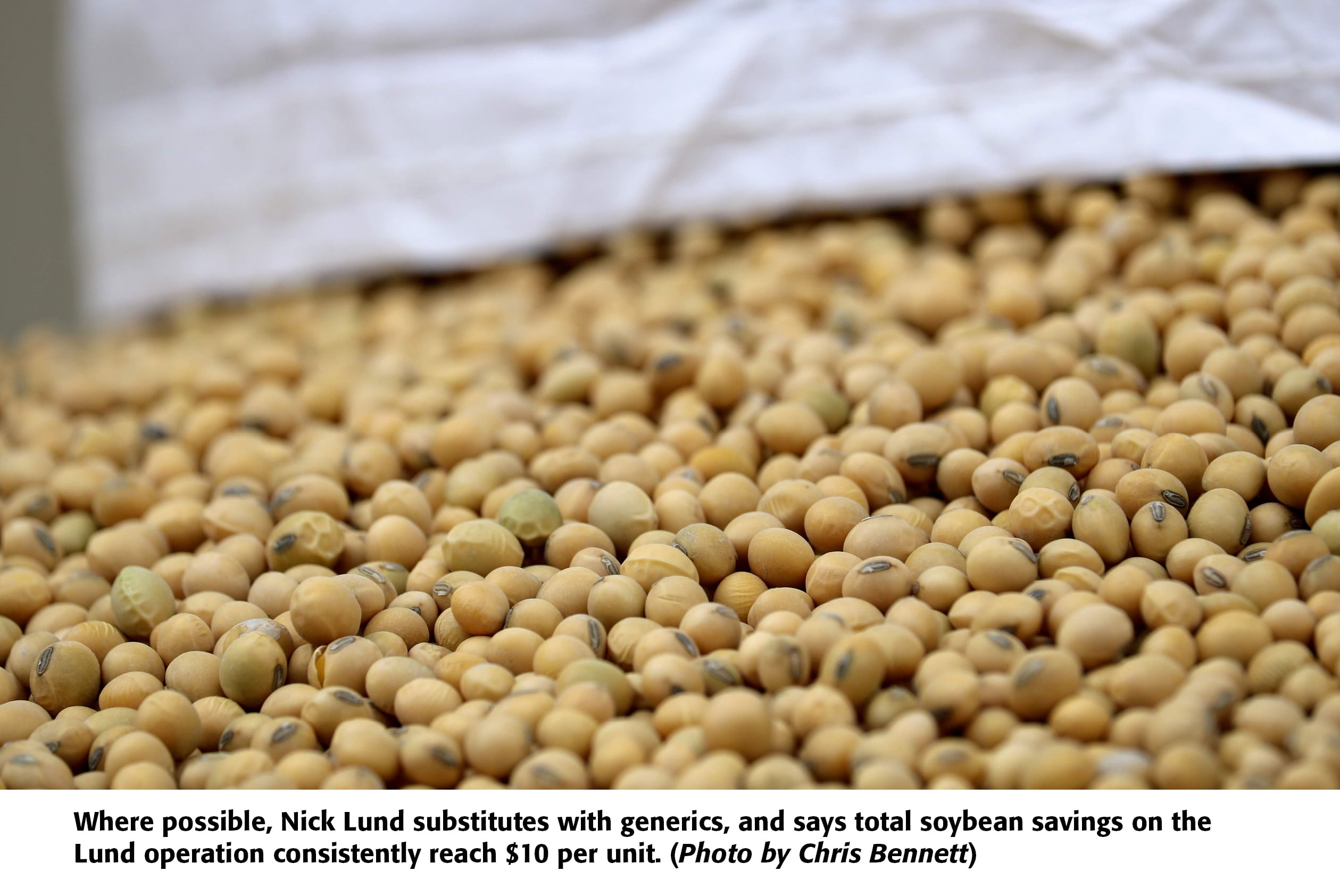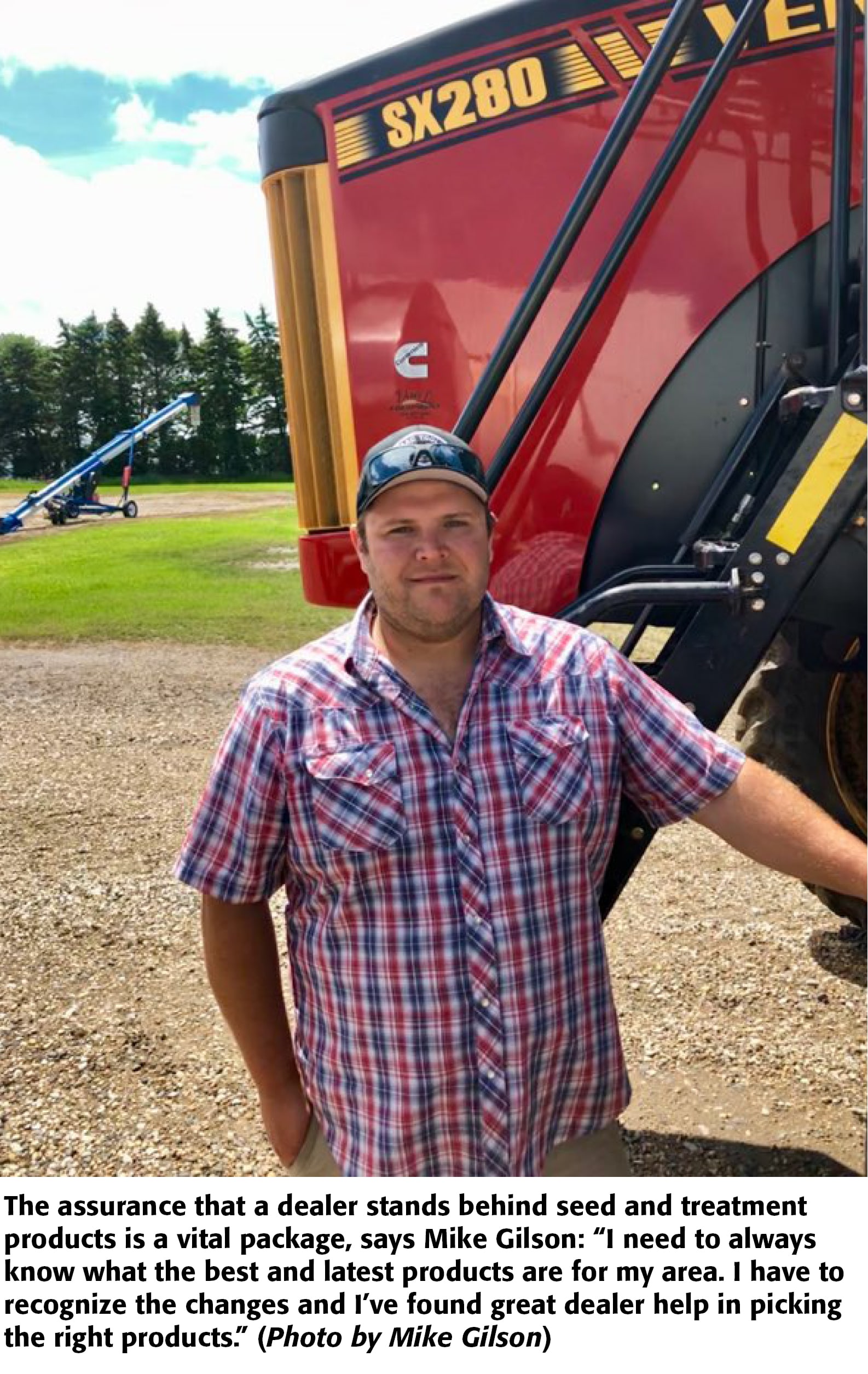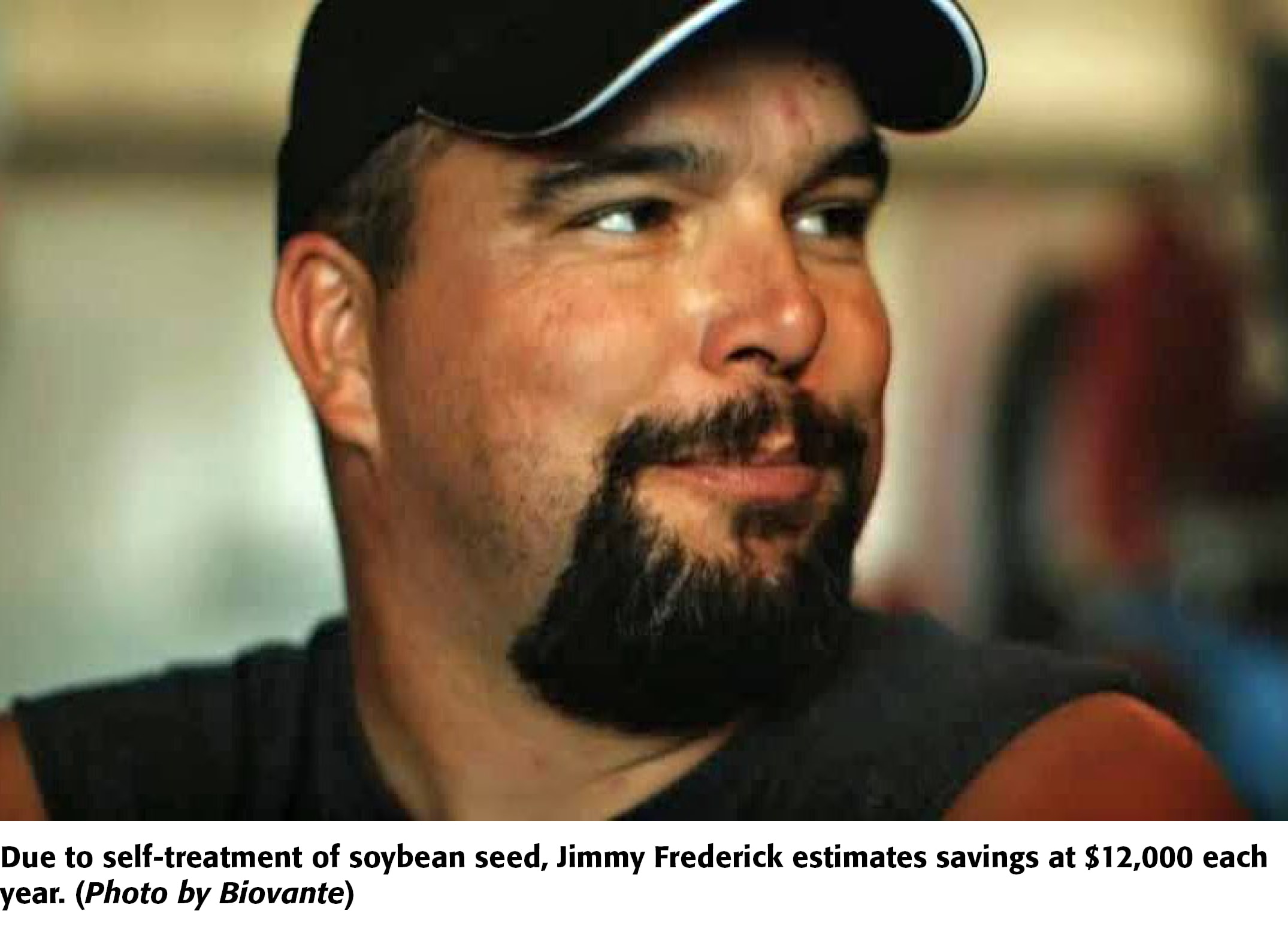Rattling the bones of a junked combine, Tom and Pat Belzer pulled the unloading auger off a 1978 Massey-Ferguson 750, set to work in their farm shop, and cobbled together a self-made seed treater. Boiled down, the device is a hopper perched above an auger on wheels, and the simple setup sometimes saves the farming brothers up to $5 per unit during soybean planting.
Treating seed in the shop carries appeal for many growers, whether attracted by savings, control or planting logistics. Four growers stretched across farm country—Indiana, Manitoba, Nebraska and North Dakota—weigh in on the considerations that spurred them to on-farm seed treatment or kept them covered comfortably by retail solutions.
North Dakota
Forty miles south of the Canadian border, and 105 miles west of Minnesota, outside Cando, N.D., the Belzers (Tom, Pat, and his wife, Kim) grow 6,500 acres of canola, corn, soybeans, spring wheat, and an occasional mix of edible beans or flax. The Towner County producers began growing soybeans in the late 1990s, and started with self-treatment in 2007. “As a main reason, it allowed us to buy seed early, take delivery, and get a better discount. Also, we go in during December or January to buy treatments, and take delivery to get better discounts. It changes each year, but it’s steady savings,” Tom says.

Typically, the Belzers begin planting (soybean acreage bounces between 200 to 2,500 acres) around May 15, and adapt treatment timing to weather. “It’s a no-brainer for us because we can wait until the last second when necessary. A retailer or co-op can’t operate 24 hours a day and they can’t show up just because we have a change in plans. The reality of farming, at least on our operation, is that self-treating seed is easier.”
Their homemade seed treatment system creates a narrow, flat ribbon of seed that falls 2’ into the auger, with a nozzle on each side of the ribbon. “We apply a fungicide and an inoculant, Tom notes. “The treatment isn’t 100%, but it’s 98% coverage and that’s good enough for us.”
Depending on chemicals and acreage in a given year, Tom estimates savings on soybean treatment at between $1.75-$5 per unit. The farming duo buys name-brand treatment products if costs are close, but also uses particular generics based on personal experience. “We try to be a low-cost input operation, but not use cheap products,” Tom says, “so we manage expenses by working hard to find the lowest costs.”
Indiana
In northeast Indiana’s Huntington County, alongside his father, Kyle, Nick Lund grows 1,600 acres of corn and soybeans, and serves as eastern regional manager for Farmer’s Business Network (FBN). In 2016, Lund, 31, partnered with a farming neighbor who owns a seed treater.
“We penciled buying one ourselves at between $20,000-$30,000, and may do that in the future. We could pay for it in about three years.”

Lund’s three-year payoff estimate is based on his approximation of $8,500 saved each season due to self-treated soybeans. He applies a blend of two fungicides, one insecticide, and inoculants when ground conditions are difficult. Timing flexibility for years like 2019, he says, is invaluable: “We don’t get stuck with early decisions. We do it almost live and know what we need right at planting, and make one pass at the seed.”
It takes roughly 12 hours of setup, run-time and tear-down for Lund to treat 800 units of soybeans. He acknowledges the pitfalls of self-treatment. “If you don’t use the seed or over-treat, then you can’t sell it as marketable grain and the seed companies won’t take it back, but we’ve never had a problem. Maybe we didn’t get 100% coverage at first, but we learned quick and there wasn’t a real learning curve.”
For interested growers, Lund recommends taking account of price differences between treated and untreated seed, and next factoring the costs of treatment products. Where possible, he substitutes with generics, and says total soybean savings on the Lund operation consistently reach $10 per unit. “FBN Direct has been big in allowing me to compare generics to branded seed treatments,” he adds.
“Every farm is different. Put a pencil to paper and ask, ‘I’m treating x amount of units: So what is the savings off the top if I do so myself?’ Then add in a discussion of investment costs, time costs, neighbor sharing and whatever else might be unique to your farm.”
Manitoba
Mike Gilson farms 4,000 acres in Canada, roughly 14 miles above the North Dakota border. Gilson, 33, grows barley, canola, oats, soybeans, spring wheat and yellow peas in Medora, located in the southwest corner of Manitoba.

When soybeans gained popularity as a relative newcomer in the Medora area, Gilson began growing the oilseed in 2015, and wanted to be spot-on with varieties, treatment, and guidance. “I turned where I could trust and that was Nielsen Seed, and I work side-by-side with them, and take advantage of early booking program discounts on product and seed to provide a little more freedom on cost. I know exactly how much treatment to the ounce is going on my beans and the precise cost for each product, and even how long each batch was treated. It all equates with peace of mind.”
Further, Gilson isn’t charged a treating rate—no application fee. In addition, he gleans data from Nielsen’s independent field plot data, and frequently participates in the trials. “I have a partnership and a close relationship with a dealer who has a farmer’s interest at heart. I don’t get banged with treating costs. Also, I know the exact amount of product on my seed, his machine is calibrated perfectly, it’s clean, and everything is accurately applied.”
The assurance that a dealer stands behind seed and treatment products is a vital package, Gilson says. “Everyone is different and you may have to change products just a few miles south in Grand Forks. I need to always know what the best and latest products are for my area. I have to recognize the changes and I’ve found great dealer help in picking the right products.”
“Seed treatment is crucial,” he continues, “and I understand why guys consider all options. Again, I’ve got peace of mind that this is the right way for me.”
Responsibility for due diligence regarding treatment products rests on grower shoulders, Gilson concludes. Considering the steady flow of new treatments on the market, he urges a trust-and-verify approach: “We’re bombarded with new stuff and many are not value-adders for your region, so do your homework. Ask reps lots of questions, get in your truck and go to a trial or field day, and talk to other farmers. Choosing the right product for your area is key.”
Nebraska
In 2016, Jimmy Frederick, 37, paid under $30,000 for a seed treater—and says the investment was money well spent. Most years, he works 2,500 acres of corn and soybeans in Richardson County, tucked in the southeast corner of Nebraska. (Frederick’s 2019 planted acreage took a severe cut due to heavy spring floods.)

“Everything—insecticide, inoculant and biologicals—is put on in a single pass. It’s just not a big learning curve and I got it down pretty quick.”
Echoing Lund, Frederick says timing flexibility is a major benefit of self-treatment, and enables him to “hold beans till the last minute.”
Due to self-treatment of soybean seed, Frederick estimates savings at $12,000 each year. “I’ve also got customers now and I treat for them as well. I don’t know if owning a treater is for everyone, but I haven’t run into any problems at all and having a treater is a great fit on my farm.”
For more, see:
Breaking Bad: Chasing the Wildest Con Artist in Farming History
Against All Odds: Farmer Survives Epic Ordeal
Killing Hogzilla: Hunting a Monster Wild Pig
Shrimp Farmer Hits Home Run in the Heartland
Agriculture’s Darkest Fraud Hidden Under Dirt and Lies
Blood And Dirt: A Farmer’s 30-Year Fight With The Feds
In the Blood: Hunting Deer Antlers with a Legendary Shed Whisperer
Who Killed the Finest Soybean Soil in the World?
Seeds of Discord: Crossing the Great Cover Crop Divide
Living the Dream: Honoring A Fallen Farmer
Read original article: https://cattlemensharrison.com/treating-seed-on-the-farm-carries-appeal-for-many-growers-whether-att/
By: Agweb
